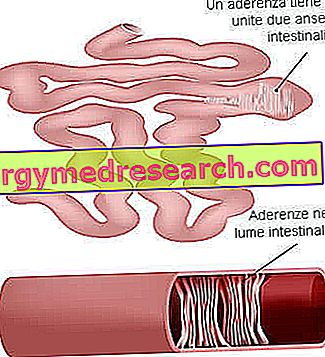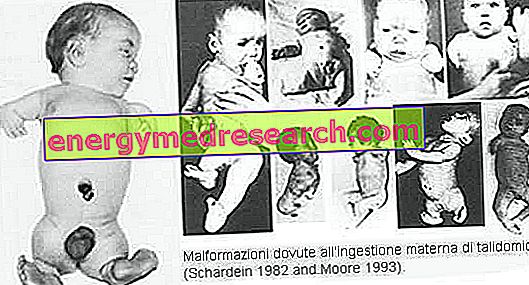Generality
The adhesions are bands of fibrous-cicatricial tissue, which anomalously join separate parts of the same organ or distinct organs or tissues, among which there is a direct contact.

Intestinal adhesions as a possible cause of intestinal obstruction: these are bundles of fibrous tissue (internal scars) that form as a result of trauma, inflammatory processes or surgery
Adhesions can form anywhere; however, they have a predilection for the organs of the abdomen (abdominal adhesions), the organs of the pelvis (pelvic adhesions) and the heart (cardiac adhesions or pericardial adhesions).
The formation of adhesions is a consequence of the body's repair mechanisms, which arise from tissue lesions due, for example, to surgery, an infection, a severe blunt trauma, a severe inflammatory state or exposure to ionizing radiation.
What are adhesions?
The adhesions are bands of fibrous-cicatricial tissue, which anomalously join normally disjoint parts of the same organ or distinct organs or tissues, among which there is a relationship of extreme closeness or even mutual contact.
Any part of the body can be subject to adhesions; however, abdominal organs and tissues (ie the abdomen), pelvic organs and tissues (ie pelvis) and heart have a greater predisposition to the problem in question.
Causes
The development of adhesions is a consequence of the repair mechanisms of the body, set in motion by insults or tissue lesions that can take place after surgery, a particular infection, a strong blunt trauma, an inflammatory state or exposure to radiation harmful ionizing agents.
The possibility of adhesions forming depends on the inability of the cells assigned to the aforementioned repair mechanisms to distinguish the different portions of the same organ or two different anatomical structures, if among them there is a continuity.
In other words, the formation of the adhesions is the result of reparative processes that, by nature, are not very precise: the repairing cells know where to act and when to act, but they do not know how to recognize the various portions of an organ or two distinct organs / tissues, therefore they operate indiscriminately.
Types
There are various types of adhesions. The distinction criterion for the various types is, as can be guessed, the location of the organs or tissues involved.
The most common types of adhesions include abdominal adhesions, pelvic adhesions and cardiac adhesions .
Among the less common types of adhesions, on the other hand, we note: peridural adhesions, peritendinous adhesions and adhesions to the shoulder capsule (also known with the terms of adhesive capsulitis of the shoulder or frozen shoulder ).
ABDOMINAL ADHERENCES
The adhesions concerning the internal organs or tissues of the abdomen are called abdominal adhesions.
If conspicuous, the presence of abdominal adhesions alters not only the normal anatomy of the organs / tissues involved, but also their functionality.
The most common site of abdominal adhesions is the intestine .
This organ lends itself to the formation of adhesions due to its particular anatomy: it is a very long cylindrical structure, with numerous foldings on itself and different points of contact, which concern portions even very distant from each other.
Other abdominal adhesion sites of a certain importance are the liver and gall bladder .
In about 90% of cases, the presence of abdominal adhesions is due to a previous surgical operation performed in the abdominal area; in the remaining 10% of the circumstances, however, it may depend on one of the following conditions:
- Severe appendicitis;
- Ulcerative colitis;
- Severe infectious gastroenteritis;
- Congenital tissue anomaly;
- A sexually transmitted disease, such as gonorrhea, chlamydia, etc.
Abdominal adhesions tend to be asymptomatic (ie without symptoms).
However, if their presence is conspicuous and involves particularly sensitive organs or tissues, they can cause a painful sensation in the abdomen and, in extreme cases, give rise to a series of complications.
As a rule, to formulate a correct and reliable diagnosis of abdominal adhesions, exploratory laparoscopy is essential; Exploratory laparoscopy is a minimally invasive surgical technique, which allows the inside of the abdominal-pelvic cavity to be viewed using a small number of small skin incisions.
The current treatment of abdominal adhesions consists of a surgical intervention aimed at removing the bands of fibrous-cicatricial tissue. Generally reserved only for symptomatic and symptomatic cases with complications, the aforementioned surgery is called adesiolysis .
Today, surgeons can rely on two surgical techniques to perform adhesiolysis: therapeutic laparoscopy and laparotomy .
Adesiolysis is effective, but could prove to be a double-edged sword, as, being an abdominal surgery operation, it can lead to the onset of new abdominal adhesions.
Symptoms and complications of adhesions to the intestine
The presence of adhesions at the level of the intestine can determine a narrowing of the intestinal lumen and jeopardize the regular passage of digestion products.
In less severe cases, the aforementioned shrinkage is responsible for chronic pain in the abdomen, sometimes associated with symptoms such as diarrhea, constipation, abdominal cramps and / or a sense of vomiting; in the most serious cases, on the other hand, the aforementioned narrowing may lead to a clinically very relevant condition, known as intestinal obstruction or intestinal blockage .
In medicine, we talk about intestinal obstruction when the intestine is blocked and does not allow what is flowing inside to progress further.
Intestinal obstruction is a medical emergency, which must be remedied immediately if further consequences (such as bleeding, infections and / or intestinal perforation) are to be avoided.
PELVIC ADHERENCES
Definitely more common in the female population, the pelvic adhesions are the adhesions that involve one or more pelvic organs; the organs of the pelvis of the human being are:
- Bladder;
- Urethra;
- Rectal intestine;
- Colon sigma;
- Uterus, fallopian tubes, vagina and ovaries, in women;
- Prostate, seminal vesicles and vas deferens, in men.
In order of importance, the main causes of adhesions at the level of the pelvic organs are: pelvic surgery, two exclusive conditions of female sex known as endometriosis and pelvic inflammatory disease and, finally, sexually transmitted diseases such as gonorrhea, chlamydia etc.
When they are not asymptomatic, the pelvic adhesions cause a characteristic persistent painful sensation, better known as chronic pelvic pain ; this painful sensation can originate from the compression of a nerve, operated by the same adhesions, or by the anomalous stretching of part of the organs presenting the bands of fibrous-cicatricial tissue.
In some unfortunate cases, pelvic adhesions may have unpleasant consequences: for example, adhesions to the fallopian tubes may result in a state of infertility, by the affected woman, and increase the chances of ectopic pregnancy ; the adhesions to the vagina or uterus, on the other hand, can be the cause of an annoying pain during sexual intercourse .
Regarding the diagnosis, treatment and prognosis of pelvic adhesions, the following applies to the diagnosis, treatment and prognosis of abdominal adhesions. Therefore:
- The search for pelvic adhesions and the analysis of their characteristics (size, location, etc.) are based on the execution of an exploratory laparoscopy;
- The elimination of pelvic adhesions requires the intervention of the surgeon, who can operate in laparoscopy or in laparotomy;
- The current pelvic adhesiolysis procedures guarantee good results, but they are, to all effects, pelvic surgery, which can induce the appearance of new adhesions in the same site.
What surgical operations, in women, are the cause of most cases of pelvic adhesions?
In the female population, the pelvic surgery that causes most cases of adhesions to the pelvic organs are: myomectomy (ie the elimination of uterine fibroids), endometrial ablation and uterine scraping .
CARDIAC ADHERENCES
With the terms cardiac adhesions or pericardial adhesions, doctors mean the adhesions that are located at the level of the heart (in particular heart valves ) and of the pericardium (ie the membranous sac that envelops and protects the heart).
The main causes of cardiac adhesions are cardiac surgery and infections affecting the heart or which have, in some way, repercussions on the latter, such as rheumatic fever .
Cardiac adhesions can:
- Limit the contractile capacity of the heart, establishing a condition known as constrictive pericarditis, e
- Altering the function of heart valves .
The appearance of a symptomatology depends on the presence of constrictive pericarditis and on the non-functioning of the heart valves, which includes: chest pain, dyspnea, sense of recurrent fatigue, swelling of the lower limbs and generalized weakness.
For a correct and safe diagnosis of cardiac adhesions, doctors generally rely on: physical examination, medical history, an echocardiogram and a CT scan (or, alternatively, a nuclear magnetic resonance) of the chest.
If responsible for constrictive pericarditis and / or functional alteration of the heart valves, cardiac adhesions require the intervention of the cardiac surgeon, who will perform specific operations on the pericardium ( pericardial decortication ) and / or on the valves involved ( repair / valve replacement ).
The surgical procedures for resolving the consequences induced by cardiac adhesions are very delicate.



